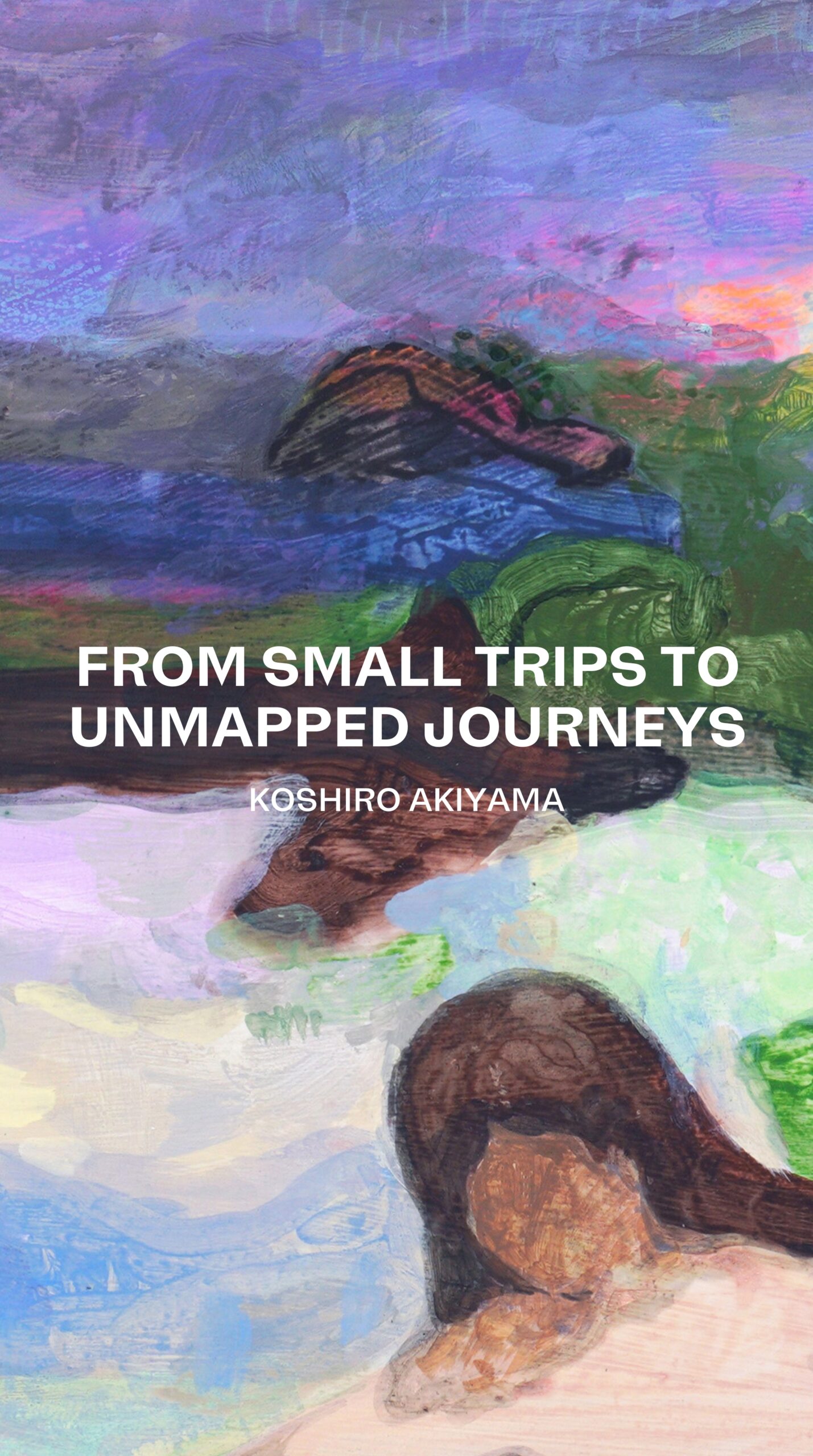

A quiet passage from the intimate and personal to the open and unknowable, From Small Trips to Unmapped Journeys invites viewers to drift through meditative painterly terrains, stroll through spaces where recollection becomes reverie, and inhabit worlds in which wandering itself becomes a quiet form of understanding the world. A solo exhibition featuring Koshiro Akiyama’s dreamlike paintings, the selection of works on show emphasize emotion over realism, thus aligning his practice with a broader lineage of Expressionist painters who sought to externalize internal states rather than represent the visible world.
Like Edvard Munch, whose anguished figures inhabit vibrating fields of color and air, Akiyama constructs ethereal canvases within which psychological unease and fragile hope coexist. It is also possible to trace affinities with Franz Marc’s symbolic landscapes, where form and color become conduits for emotion, whilst Akiyama’s subdued palette and fluid handling of pigment recall Paul Klee’s poetic balancing of fragility and depth, as well as Egon Schiele’s sensitivity to the body as a site of psychological tension. Yet Akiyama reframes this inheritance through his dual grounding in Japanese and Western painting traditions. In this synthesis, he transforms Expressionism’s existential urgency into something quieter but no less profound —a contemporary form of psychological landscape painting that turns wandering, fatigue, and contemplation into painterly emotion.
Beginning with small or fleeting moments, Akiyama’s practice transforms the intimate act of looking into an open journey of the psyche and imagination. Emerging from a delicate balance between traditional materials and contemporary sensibilities, Akiyama bridges two pictorial languages. Trained in both Japanese and Western painting traditions, he employs Nihonga by melding the refinement of mineral pigments, ink, and animal glue, with the fluid spontaneity of contemporary acrylic, gouache, and watercolour. His working process is slow and meditative, often beginning with a fleeting memory before dissolving the reference into something atmospheric and ambiguous. Through the repeated application of thin washes and layered pigments, he constructs surfaces that breathe, hovering between opacity and transparency, figuration and abstraction. The figures in his compositions frequently appear lost in wondrous journeys, isolated or partially dissolved into their environments, reflecting introspection as well as an instability of presence and perception. Landscapes tilt or flatten, bodies waver between emergence and disappearance, and light behaves as both substance and emotion. Subtle and restrained, Akiyama’s brushwork embodies the quiet persistence of observation for his works are less depictions of scenes than records of duration and sensation.
Revolving around the idea of wandering, Akiyama’s imagery often arises from recollected experiences: a walk through a park, a glimpse of sky through a window, a moment suspended between fatigue and awareness. These once trivial moments accumulate in his mind and resurface unconsciously as visual metaphors for emotion and memory. Fluid and emotive, Akiyama’s explorations of the subconscious are imbued with a sense of stillness that is all the same charged with a tension between despair and release, weight and lightness. Akiyama frequently describes his process as meditative, or a means of navigating depression and mental restlessness; through painting, he seeks not resolution but illumination. The resulting works form psychological landscapes where interior states become visible as mist, gravity, or colour. His pieces thus inhabit a space between the seen and the felt, evoking the transient beauty of uncertainty and the quiet resilience of the human spirit. Each painting feels like a fragment of a longer, unfinished voyage —one that moves gently from introspection toward release. Wandering without direction, while hinting at gradual transformation, Akiyama’s works trace the contours of an aimless, intimate journey suffused with fatigue, desperation, and escape that gradually gives way to relaxation, observation and contemplation. In this sense, his paintings echo Emily Dickinson’s notion that the most profound voyages are those taken inward —journeys of perception rather than of place— where wonder itself becomes both compass and destination. Together, they trace the passage from the everyday to the existential, from memory to imagination, from the familiar to the strange, and back again. These images, accumulated over time, guide not toward a destination, but toward the journey of seeing and feeling themselves.

Revolving around the idea of wandering, Akiyama’s imagery often arises from recollected experiences: a walk through a park, a glimpse of sky through a window, a moment suspended between fatigue and awareness. These once trivial moments accumulate in his mind and resurface unconsciously as visual metaphors for emotion and memory.



Fluid and emotive, Akiyama’s explorations of the subconscious are imbued with a sense of stillness that is all the same charged with a tension between despair and release, weight and lightness. Akiyama frequently describes his process as meditative, or a means of navigating depression and mental restlessness; through painting, he seeks not resolution but illumination.





Wandering without direction, while hinting at gradual transformation, Akiyama’s works trace the contours of an aimless, intimate journey suffused with fatigue, desperation, and escape that gradually gives way to relaxation, observation and contemplation. In this sense, his paintings echo Emily Dickinson’s notion that the most profound voyages are those taken inward —journeys of perception rather than of place— where wonder itself becomes both compass and destination. Together, they trace the passage from the everyday to the existential, from memory to imagination, from the familiar to the strange, and back again. These images, accumulated over time, guide not toward a destination, but toward the journey of seeing and feeling themselves.
ARTWORKS